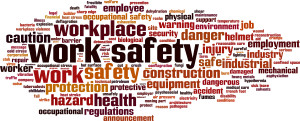An HBW Safety Update on the latest fact sheet published by OSHA

We often review OSHA’s safety updates and encourage regular review and reinforcement of safety policies, and while most information is geared to all team members, OSHA recently provided a fact sheet “Safety Walk-Arounds for Managers” that is directed to team managers.
Albeit it brief, the fact sheet is important as it provides suggestions for conducting safety inspections that can enable you to evaluate the effectiveness of your current safety and health practices.
Although it should be no secret as to why safety inspections are important, OSHA lists two important purposes:
- Inspections demonstrate management’s commitment to improving safety and health by finding and fixing hazards.
- Walk-arounds let managers see for themselves how their safety and health program is working and whether it is effective in identifying and eliminating hazards.
The fact sheet lists a safety walk-around in three steps: Before, during and after inspection:
Prepare:
Identify the most hazardous areas by examining past inspection reports, injury and workers compensation records, incident investigation reports, and recent near-miss incidents. Develop a plan of action so that your inspections focus on the appropriate hazards and concerns. Communicate and gain feedback from all parties involved, and talk to workplace safety representatives and other managers about their safety observations and concerns. Your plan should include safety equipment needed and areas to look for when onsite.
During Inspection:
When onsite, inspectors and managers should be wearing all of the correct Personal Protective Equipment (PPE) for each area. Limit the group of inspectors to only necessary parties as to not overwhelm or intimidate workers. When inspecting, look for obvious hazards including but not limited to: tripping hazards; blocked exits; frayed/exposed electrical wires; missing machine guards; poor housekeeping; poorly maintained equipment; property damage. Observe workers as they perform their job. For example, do they lift heavy objects? Do they stand/sit in awkward postures? Are they performing repetitive motions? If so, document it through notes and photos.
While observing activities and conditions is vital to conducting a successful inspection, the process should not be limited to observation. Communication is a critical component, and it is important to talk to and interact with team members. OSHA suggests asking open-ended questions such as:
- What is the most hazardous task in your job? What makes it hazardous?
- If you have been injured in your job, what was the injury and how did it happen? What was done to make your job safer?
- How would you report an injury, hazard, or near-miss?
Post-Inspection
Your inspection will only be as effective as your follow-up. Lack of follow-up can lead to discouraged crews and failures in your safety structure. OSHA suggests that immediately following your inspection you should:
- Prepare an abatement plan containing a list of the hazards found, corrective actions needed, and a reasonable timeline for implementation.
- Share the abatement plan with managers, supervisors, and workers as a way of showing your commitment to fixing the safety issues found during your inspection.
- Track progress by sharing or posting periodic updates to the plan. Ensure all corrective actions are implemented in a timely fashion.
For managers who are conducting safety walk-arounds, the general guidelines provided are a good place to start. The communication that takes place during a safety walk-around is just as important as locating and identifying hazards, as it is a chance to engage in mutually respectful communication that can lead to improved team morale, greater onsite safety and increased productivity.
For more information on construction business and marketing tips, stay connected with the HBW Blog. To get ahead of construction activity and gain access to the latest permitting data in Florida, Texas, Georgia, Alabama and Oklahoma, contact HBW for more information on construction data reports and industry leads.
